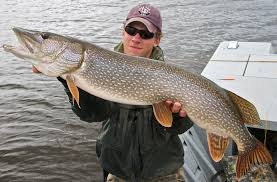The Pikeposted on 8 February 2015 | posted in Hints and TipsCommon name: Pike Latin name: Esox lucius  Record weight: 46lb 13 oz caught from Llandegfedd Reservoir in Wales by R. Lewis in 1992. Distribution: One of the most widespread of all freshwater fish. Found throughout Northern Europe and North America, the pike is a fish of the temperate waters of the Northern Hemisphere. In the UK, pike can be found in every county of England, except Cornwall and throughout most of Scotland, Wales and Ireland. Being the main apex predator found in freshwaters, pike are not as common as other fish. It has previously been estimated that, on average, most fisheries can sustain one pound of pike for every pound of fodder fish. Features: Pike cannot be mistaken for any other fish in British waters. From their mottled green appearance, sleek body and armoury of razor sharp teeth, the whole body of the pike is designed for hunting down live fish. Pike are ambush predators, mounting a lightening quick attack that lasts only a few seconds. All of the fins of the pike are positioned well back on the body, giving them maximum acceleration from a standing start when lunging at prey. Diet: Once pike reach a length of approximately 10 centimetres they become almost totally piscivorous. Large pike may also take the occasional water bird, or frog, but for the most part their diet is made up of fish up to one third their own body length. In extreme environments pike may feed almost exclusively on their own kind. In some Highland lochs, where pike are the only fish species present, the small pike will feed on invertebrates and the larger pike will feed upon the small pike. In such environments the pike are very slow growing and reach much smaller maximum sizes than their lowland cousins. Spawning: Pike spawn during March and April in the shallow weedy margins of lakes and in the tiny overgrown backwaters of rivers. Male pike tend to arrive at the spawning sites a few days before the females and jockey for the best positions on the edges of the weed beds. When the females arrive they rest up in deeper water until conditions are perfect for spawning. The much larger females make their way up the marginal slope into shallow water attracting a number of small males. The males follow the female into shallow water where spawning can take place in water less than 15 centimetres deep. In large lakes pike will often spawn on grass that has been inundated by high water levels. By spawning on this temporary habitat the eggs are relatively safe from predatory invertebrates and receive the full force of the warmth of the sun. Growth: In most fisheries pike grow very quickly. From the time they hatch to the end of growth in October they will reach a size of fifteen centimetres and be feeding solely on other fish. Pike are relatively short lived, living for perhaps only fifteen years. The fish effectively double in weight during the early years, only slowing in most fisheries when they reach a weight of ten pounds or more. In exceptional circumstances, generally where food is very abundant, such as in trout fisheries, the large fish will continue to grow right through their lives. Male pike rarely reach a weight of more than eight pounds. All large pike are females. As female pike may contain several hundred thousand eggs; their large size is essential to store such a huge mass. Even so, the eggs may account for 25% of the weight of the fish during the Spring period. Although most pike fishing is carried out in the Winter months, pike feed hardest and put on their weight during the Summer. Like all coarse fish, growth cannot take place during the cold conditions found in Winter. Pike are much more active in the Summer and may become highly nocturnal, or crepuscular, feeding when light conditions are low and they are best able to creep up on their prey |








.jpg)
.jpg)





